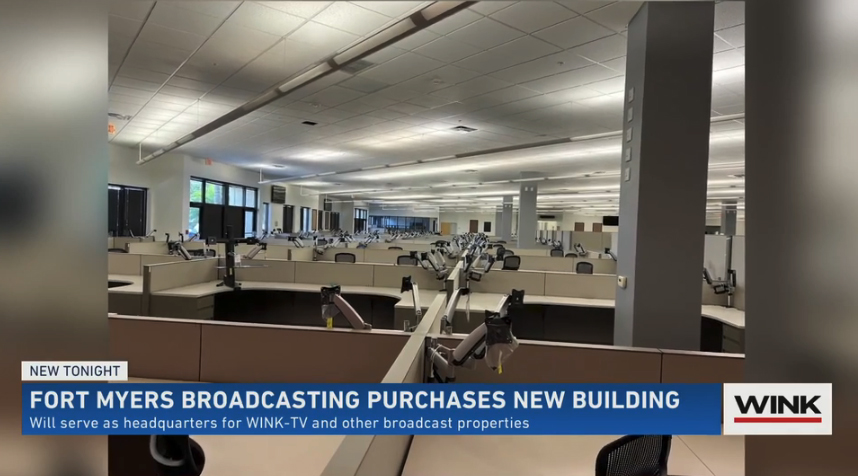Ft. Myers station buys new home

Subscribe to NewscastStudio for the latest news, project case studies and product announcements in broadcast technology, creative design and engineering delivered to your inbox.
Ft. Meyers CBS affiliate WINK has announced it has found a new home for its various media operations.
The station has been based at 2824 Palm Beach Blvd. in Ft. Myers, Florida, since 1954. That building, branded as “Broadcast Center,” sits closer to the heart of the city, but is also situated close to the Caloosahatchee River and a small inlet, both of which contributed to extensive flooding of the station in 2014 during Hurricane Ivan.
The station, which is owned by the family-run Fort Myers Broadcasting Company, has agreed to pay $18.5 million for the new facility.

The new space has 57,260 square feet and a 5.6 acre parking lot and was previously a Comcast Xfinity service and dispatch center, though it did not contain any broadcast production facilities.
The station also considered another property but settled on the 12641 Corporate Lakes Drive spot because it has a higher ceiling height and more parking.
It also sits southeast of the city center and well away from any major body of water, which should reduce the likelihood of flooding.
WINK is planning to complete the move to the new facility within a year. Images shown on the station’s newscasts showed a building outfitted with an open office concept that could be ideal for a variety of TV station operations, including a newsroom.
The station will have to build out a new studio and associated support facilities, however.
The new building will serve as the corporate headquarters for Fort Myers Broadcasting Company, Sun Broadcasting Company and Gulf Shore Life Media.
Sun Broadcasting runs three stations through SSAs with their owners: CW affiliate WXCW, low-power Univision station WUVF-LD low-power Azteca América affiliate WANA-LD.
WINK itself also carries Antenna TV and MyNetwork TV programming plus a handful of audio-only radio feeds on its subchannels.
No plans were announced to move the station’s transmitter or radar tower near Babcock Ranch, Florida.
Flooding triggered by severe weather is a common headache for TV stations across the country, though shifts in broadcast facility design and placement are changing that.
It had been common for TV stations to occupy buildings close to heart of the cities they serve, which also put many of them in prime flooding zones thanks to the nearby bodies of water that originally attracted settlers to a region.
There has been an increasing trend of stations leaving city centers for space on the outskirts of town or even suburban cities. Other stations owners, wanting to stay closer to the city core, have opted to move into the upper floors of buildings.
Industrial and office complex park-like settings such as the one WINK bought are attractive prospects for stations because they tend to have a large, open spaces that can either be built-out or modified to meet the needs of broadcast stations fairly easily.
Single-floor facilities are often more attractive because they tend to have higher ceiling heights, giving stations more flexibility for building out studios and running cabling.
Other stations have opted to renovate former commercial properties that once housed mid-size tenants in shopping centers, again thanks to the open space and high ceilings.
It’s also been a common trend in the industry to build new broadcast facilities from the ground up, often in office park-like settings.
While there are advantages to a purpose-built facility, new construction can also take more time. Real estate trends since the COVID-19 pandemic have also seen more commercial office space become available, which could make retrofitting space more appealing to stations.
Modern TV broadcast facilities typically require at least some open-concept space with relatively high ceiling space for a studio. Open plans also work well for newsrooms and workspaces for advertising, marketing and other departments.
Due to the amount of technical infrastructure, TV facilities can also benefit from higher ceiling heights so raised flooring or ceiling tracks can be installed to handle the miles of cables often required to deliver signals from various equipment around the building.
Parking for employee and fleet vehicles can also be a concern, as well as space for installing backup generators that can supply the building with electricity in the event of power failures.
Broadcast facilities also often come with a heavy amount of security requirements, including gated parking lots and secure entries. As media outlets, TV stations can attract unwanted attention from trouble-makers and also need to be able to defend high-profile talent and the millions of dollars worth of equipment inside the building — not to mention protecting the integrity of the public broadcast signals it is outputting.
Subscribe to NewscastStudio for the latest news, project case studies and product announcements in broadcast technology, creative design and engineering delivered to your inbox.




tags
Broadcast Facility, Broadcast Facility Planning, Ft. Myers, wink
categories
Broadcast Facility, Broadcast Facility Technology, Broadcast Industry News, Featured, Local News